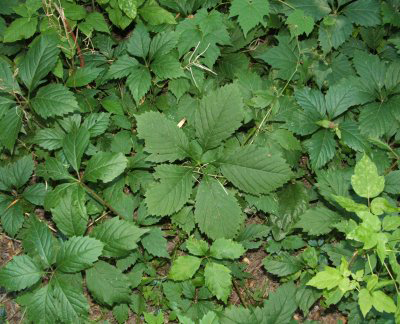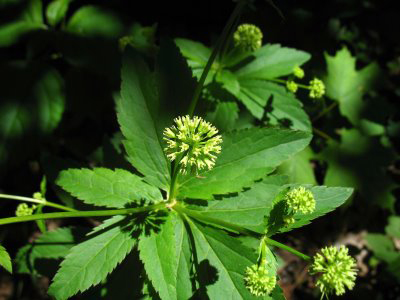Contents:
Common Names | Parts Usually Used | Plant(s) & Culture | Where Found | Medicinal Properties
Uses | Formulas or Dosages | Bibliography
Scientific Names

- Sanicula marilandica L.
- Umbelliferae
- Umbel family
Common Names
- Black sanicle
- Black snakeroot
- Butterwort
- Pool root
- Sanicle
- Sanicle root
- Wood sanicle
Parts Usually Used
Rootstock, leaves
Back to Top
Description of Plant(s) and Culture

American sanicle is a perennial plant; the root is composed of many blackish strings or fibers. The fibrous rootstock produces a light-green, furrowed, hollow stem bearing a few sessile leaves or none at all. Most of the plant’s bluish-green, palmately lobed leaves are basal, growing on long petioles. Small umbels of white, greenish-white, or yellowish flowers bloom from May to July. Prickled fruits sessile (without stalks); base of bristles bulbous.
Other variety: European sanicle (S. europaea) also called wood sanicle; Canadian sanicle (S. canadensis).
Back to Top
Where Found
Found in rich woods, thickets, and shores from Newfoundland south to Georgia, and west to Alberta and Colorado. Shade loving plant.
Back to Top
Medicinal Properties
Astringent, expectorant, nervine, vulnerary, alterative, discutient, depurative
Back to Top
Uses
Used as a gargle for irritations or sores in the mouth and throat, for internal ulcers, kidney ailments, rheumatism, diarrhea, digestion, fevers, colds, inflammations, swellings, wounds, tumors, gonorrhea, syphilis, blood cleanser, quinsy, tuberculosis, scurvy, tetters, rashes, erysipelas, pain, hemorrhage and excessive menstrual flow. The powdered root used for fever and chorea (St. Vitus’s dance). Native Americans used a poultice of the root for snakebite.
Back to Top
Formulas or Dosages
Infusion: steep 1 tsp. rootstock in water. Take 1 cup a day.
Tincture: a dose is from 15-30 drops.
Back to Top
Bibliography
![]() American Folk Medicine
American Folk Medicine, by Clarence Meyer, Meyerbooks, publisher, PO Box 427, Glenwood, Illinois 60425, 1973
![]() Back to Eden
Back to Eden, by Jethro Kloss; Back to Eden Publishing Co., Loma Linda, CA 92354, Original copyright 1939, revised edition 1994
![]() Culpeper’s Complete Herbal & English Physician: Updated With 117 Modern Herbs
Culpeper’s Complete Herbal & English Physician: Updated With 117 Modern Herbs, by Nicholas Culpeper, Meyerbooks, publisher, PO Box 427, Glenwood, Illinois 60425, 1990, (reprint of 1814)
![]() Eastern/Central Medicinal Plants
Eastern/Central Medicinal Plants, by Steven Foster and James A. Duke., Houghton Mifflin Company, 215 Park Avenue South, New York, NY 10000
![]() The Herb Book
The Herb Book, by John Lust, Bantam Books, 666 Fifth Avenue, New York, NY. copyright 1974.
![]() Indian Herbalogy of North America
Indian Herbalogy of North America, by Alma R. Hutchens, Shambala Publications, Inc., Horticultural Hall, 300 Massachusetts Avenue, Boston, Massachusetts 02115, 1973
 The Magic of Herbs
The Magic of Herbs, by David Conway, published by Jonathan Cape, Thirty Bedford Square, London, England. (Out of print)
![]() The Nature Doctor: A Manual of Traditional and Complementary Medicine
The Nature Doctor: A Manual of Traditional and Complementary Medicine, by Dr. H.C.A. Vogel; Keats Publishing, Inc., 27 Pine Street (Box 876) New Canaan, CT. 06840-0876. Copyright Verlag A. Vogel, Teufen (AR) Switzerland 1952, 1991
![]() Webster’s New World Dictionary
Webster’s New World Dictionary, Third College Edition, Victoria Neufeldt, Editor in Chief, New World Dictionaries: A Division of Simon & Schuster, Inc., 15 Columbus Circle, New York, NY 10023
 The Rodale Herb Book: How to Use, Grow, and Buy Nature’s Miracle Plants (An Organic gardening and farming book)
The Rodale Herb Book: How to Use, Grow, and Buy Nature’s Miracle Plants (An Organic gardening and farming book), edited by William H. Hylton, Rodale Press, Inc. Emmaus, PA, 18049., 1974
